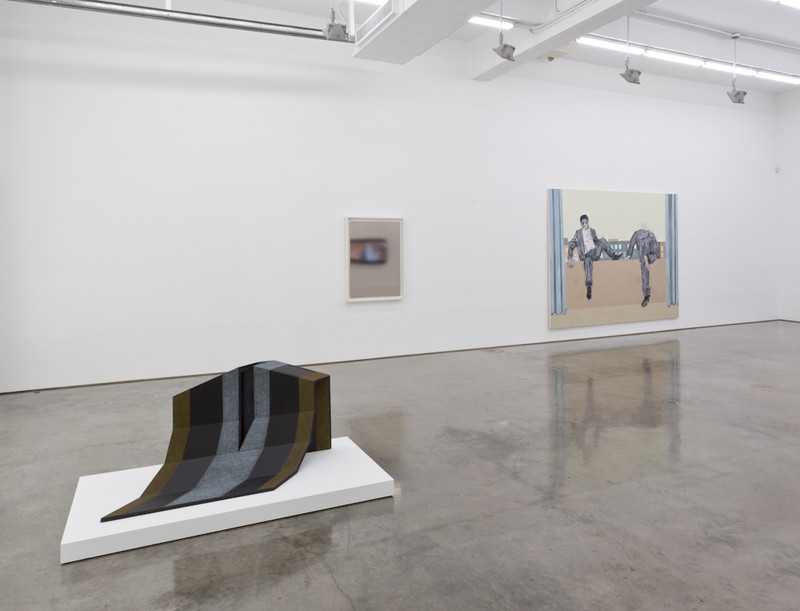See sun, and think shadow
23 Jun - 29 Jul 2016
SEE SUN, AND THINK SHADOW
23 June - 29 July 2016
Can a mote of sunlight defeat its purpose
When thought shows it to be deep or dark?
See sun, and think shadow.
- Louis Zukofsky, anew #21
Gladstone Gallery is pleased to announce See sun, and think shadow, a group exhibition organized by Simone Battisti. Featuring twelve artists working across varied media, this show will explore the formal tool of antithesis as it is manifest in works that run the gamut from video and installation, to painting and photography. The artists included in the exhibition are: Lucas Blalock, Liz Deschenes, Jessica Dickinson, Trisha Donnelly, Apostolos Georgiou, Hilary Lloyd, Shahryar Nashat, Blake Rayne, Nora Schultz, Amy Sillman, Diane Simpson, and Michael E. Smith.
Borrowing its title from Louis Zukofsky’s short poem, anew #21, the exhibition will use the binary of light/dark not as a thematic end goal, but rather as an allegorical springboard into broader dichotomies that emerge as a result of examining compositional contrariety, such as hope and despair, familiar and foreign, human and mechanical, and real and representational.
The works on view provide visual rejoinders to this investigation. Lucas Blalock’s highly constructed photographs obliterate distinctions between documentary and artifice through the artist’s use of filmic and digital photographic techniques. Apostolos Georgiou’s canvas, Untitled (2013), a composition in which narrative is just barely evident, utilizes figuration as an endeavor to upset the coherence of the picture plane. Hilary Lloyd’s video, Sailor (2010), through its presentation of the title subject in sequential images, straddles the line between prosaic observation and overt voyeurism. Shahryar Nashat’s installation, Present Sore (2016) – commissioned by the Walker Art Center, Minneapolis, and co-produced with Portikus, Frankfurt am Main – shows the body as a system of ready-at-hand tools in a format that mimics iPhone displays, thereby breaking down the boundaries between human and machine. Nora Schultz’s oversized Venetian blinds, while functional, negate their purpose without a light source to block. Amy Sillman’s animation, Triscuits (2011-2012), employs allusions to Bernie Boston’s Flower Power, Yiddish aphorism, and Soviet-era poetry as means to drive her ghostly characters through cyclical moments of expulsion and insertion. And Diane Simpson’s sculpture, an earth-toned tunic produced in rigid rectilinear form, renders utility null.
By interrogating opposites, the featured works elucidate the differences between two poles, and, in the same breath, obscure any distinctions between two seemingly incongruous parts. However, this notion of incompatibility is not a paradox. Rather, it is a tool by which to interrogate uncertainty itself: How is duality ascertained? What is gained by establishing oppositional discourses? Do elements automatically reveal their own inverse?
23 June - 29 July 2016
Can a mote of sunlight defeat its purpose
When thought shows it to be deep or dark?
See sun, and think shadow.
- Louis Zukofsky, anew #21
Gladstone Gallery is pleased to announce See sun, and think shadow, a group exhibition organized by Simone Battisti. Featuring twelve artists working across varied media, this show will explore the formal tool of antithesis as it is manifest in works that run the gamut from video and installation, to painting and photography. The artists included in the exhibition are: Lucas Blalock, Liz Deschenes, Jessica Dickinson, Trisha Donnelly, Apostolos Georgiou, Hilary Lloyd, Shahryar Nashat, Blake Rayne, Nora Schultz, Amy Sillman, Diane Simpson, and Michael E. Smith.
Borrowing its title from Louis Zukofsky’s short poem, anew #21, the exhibition will use the binary of light/dark not as a thematic end goal, but rather as an allegorical springboard into broader dichotomies that emerge as a result of examining compositional contrariety, such as hope and despair, familiar and foreign, human and mechanical, and real and representational.
The works on view provide visual rejoinders to this investigation. Lucas Blalock’s highly constructed photographs obliterate distinctions between documentary and artifice through the artist’s use of filmic and digital photographic techniques. Apostolos Georgiou’s canvas, Untitled (2013), a composition in which narrative is just barely evident, utilizes figuration as an endeavor to upset the coherence of the picture plane. Hilary Lloyd’s video, Sailor (2010), through its presentation of the title subject in sequential images, straddles the line between prosaic observation and overt voyeurism. Shahryar Nashat’s installation, Present Sore (2016) – commissioned by the Walker Art Center, Minneapolis, and co-produced with Portikus, Frankfurt am Main – shows the body as a system of ready-at-hand tools in a format that mimics iPhone displays, thereby breaking down the boundaries between human and machine. Nora Schultz’s oversized Venetian blinds, while functional, negate their purpose without a light source to block. Amy Sillman’s animation, Triscuits (2011-2012), employs allusions to Bernie Boston’s Flower Power, Yiddish aphorism, and Soviet-era poetry as means to drive her ghostly characters through cyclical moments of expulsion and insertion. And Diane Simpson’s sculpture, an earth-toned tunic produced in rigid rectilinear form, renders utility null.
By interrogating opposites, the featured works elucidate the differences between two poles, and, in the same breath, obscure any distinctions between two seemingly incongruous parts. However, this notion of incompatibility is not a paradox. Rather, it is a tool by which to interrogate uncertainty itself: How is duality ascertained? What is gained by establishing oppositional discourses? Do elements automatically reveal their own inverse?

